
Museum Guide
Gallery Guide
Curator's introduction
First footsteps
Hunting, gathering
Evidence from Thanet
Greet the ancestors
List of Displays
AHOB
NIAN
Scales in centimetre divisions
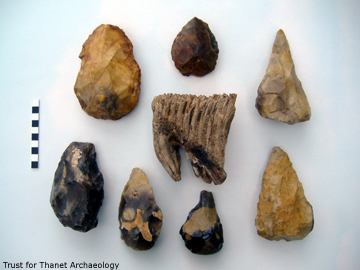
The Palaeolithic lasted
for hundreds of thousands of years in Britain. During this time the
climate
alternated between a series of glacial (cold) and inter-glacial (warm)
phases.
Archaeology has divided the Palaeolithic
into three periods based on changes in flintworking technology - these
are called the
Lower (oldest), Middle and Upper Palaeolithic.
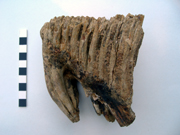
Mammoth tooth
from Riverdale Road, Sturry, Canterbury
First footsteps
The first residents of the area that would become the Isle of Thanet would likely have entered during one of the warm inter-glacial phases of the Lower Palaeolithic. Between these phases, ice sheets advanced across much of the country and gave Thanet a tundra landscape which drove people and animals further south seeking a warmer climate. Seasonal hunting of migrating herds may occasionally have brought people through the area during colder times.
The rise and fall of sea levels associated with the changes in climate may well have altered the patterns of access to Thanet. High sea levels during inter-glacial maximums may potentially have left Thanet an island and thus inaccessable for long periods during the warmest phases.
This may be one reason for the apparent rarity of evidence for Palaeolithic activity on Thanet. Similar chalk upland areas of mainland East Kent between Deal and Dover have proved to be much more productive.
The first residents of the area that would become the Isle of Thanet would likely have entered during one of the warm inter-glacial phases of the Lower Palaeolithic. Between these phases, ice sheets advanced across much of the country and gave Thanet a tundra landscape which drove people and animals further south seeking a warmer climate. Seasonal hunting of migrating herds may occasionally have brought people through the area during colder times.
The rise and fall of sea levels associated with the changes in climate may well have altered the patterns of access to Thanet. High sea levels during inter-glacial maximums may potentially have left Thanet an island and thus inaccessable for long periods during the warmest phases.
This may be one reason for the apparent rarity of evidence for Palaeolithic activity on Thanet. Similar chalk upland areas of mainland East Kent between Deal and Dover have proved to be much more productive.

A handaxe
Hunting, gathering and camping
It appears that all the Palaeolithic people lived a mobile lifestyle of hunting and gathering. How long they stayed in any one place would be dependant on the availability and quality of the local resources.
The need for fresh drinking water would have led to much of our ancestor's activities being centred around river valleys. This would also have been a good location for ambushing game who congregated in these places to drink.
River deposits often provide the best (though usually redeposited) evidence of Lower Palaeolithic activity. 19th Century quarrying of the gravel terraces of the ancient river Stour around Fordwich uncovered hundreds of handaxes. Many have also been recovered on the beach in the area of Bishopstone Glen (between Reculver and Herne Bay), having eroded from the deposits of an old water-course exposed in the cliff.
It is likely that Lower Palaeolithic camp-sites were simple affairs, with few if any rigid structures (ie. shelters) that have left an archaeological record of their existence. As humans developed we begin to find evidence for more structured (though still largely temporary) settlements and see the changes and advances in the quality of the material culture they left behind.
How much our distant ancestors relied on actual hunting activities remains a matter of debate. Some food could certainly have been obtained through opportunistic scavenging.
Evidence for hunting has been found in Britain and Europe however through the fortunate preservation of wooden spears. The end of one spear was discovered at Clacton and dated to circa 400,000 BC.
It appears that all the Palaeolithic people lived a mobile lifestyle of hunting and gathering. How long they stayed in any one place would be dependant on the availability and quality of the local resources.
The need for fresh drinking water would have led to much of our ancestor's activities being centred around river valleys. This would also have been a good location for ambushing game who congregated in these places to drink.
River deposits often provide the best (though usually redeposited) evidence of Lower Palaeolithic activity. 19th Century quarrying of the gravel terraces of the ancient river Stour around Fordwich uncovered hundreds of handaxes. Many have also been recovered on the beach in the area of Bishopstone Glen (between Reculver and Herne Bay), having eroded from the deposits of an old water-course exposed in the cliff.
It is likely that Lower Palaeolithic camp-sites were simple affairs, with few if any rigid structures (ie. shelters) that have left an archaeological record of their existence. As humans developed we begin to find evidence for more structured (though still largely temporary) settlements and see the changes and advances in the quality of the material culture they left behind.
How much our distant ancestors relied on actual hunting activities remains a matter of debate. Some food could certainly have been obtained through opportunistic scavenging.
Evidence for hunting has been found in Britain and Europe however through the fortunate preservation of wooden spears. The end of one spear was discovered at Clacton and dated to circa 400,000 BC.
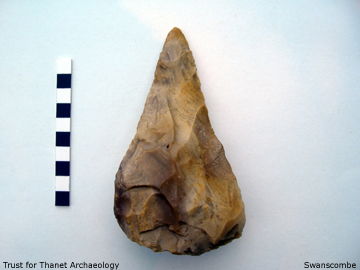
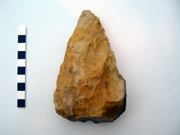
A Swanscombe handaxe
Evidence from Thanet
Evidence from the Palaeolithic period is rare in Thanet and each artefact recovered makes a vital contribution to an evolving story. Only eight flint tools, all handaxes from the Lower Palaeolithic, have been certainly identified so far.
Relatively undisturbed artefacts are most likely to be found here in the geological deposit known as 'clay-with-flints’ which occurs sporadically above the chalk. They are also often found on surviving patches of old river terraces.
Human remains of the period are incredibly rare and none have been found in Thanet. It is said that Britain's entire collection of Lower Palaeolithic human bone could probably fit into a shoe-box!
Evidence from the Palaeolithic period is rare in Thanet and each artefact recovered makes a vital contribution to an evolving story. Only eight flint tools, all handaxes from the Lower Palaeolithic, have been certainly identified so far.
The handaxe is the
archetypal flint tool of the Lower Palaeolithic. Useful for a multitude
of butchery tasks, it has been likened to a modern-day 'Swiss Army
knife'.
Most of Thanet's Palaeolithic handaxes have been moved from the places where they were originally discarded. Only one or two have been discovered in virtually their original context (or as close as we are going to get).
Most of Thanet's Palaeolithic handaxes have been moved from the places where they were originally discarded. Only one or two have been discovered in virtually their original context (or as close as we are going to get).
Relatively undisturbed artefacts are most likely to be found here in the geological deposit known as 'clay-with-flints’ which occurs sporadically above the chalk. They are also often found on surviving patches of old river terraces.
Human remains of the period are incredibly rare and none have been found in Thanet. It is said that Britain's entire collection of Lower Palaeolithic human bone could probably fit into a shoe-box!
No Middle Palaeolithic artefacts are
known to have been found here. There are only two possible flints from
the
Upper Palaeolithic period (unconfirmed at present).
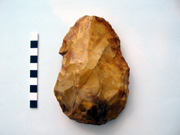
A handaxe, possibly from Bishopstone Glen, Herne Bay
Greet the ancestors
The Palaeolithic inhabitants represented by these Lower Palaeolithic handaxes are likely to be Homo Sapiens Heidelbergensis and they are not our direct ancestors. Heidelbergensis was the ancestor of the Neanderthals - Homo Sapiens Neanderthalensis, who occupied the Middle Palaeolithic period. No ancient remains of the latter are known to have been found on Thanet so far.
The Palaeolithic inhabitants represented by these Lower Palaeolithic handaxes are likely to be Homo Sapiens Heidelbergensis and they are not our direct ancestors. Heidelbergensis was the ancestor of the Neanderthals - Homo Sapiens Neanderthalensis, who occupied the Middle Palaeolithic period. No ancient remains of the latter are known to have been found on Thanet so far.
Our modern ancestors are Homo Sapiens
Sapiens who derived from the African side of the
Heidelbergensis
family. They arrived in Western
Europe around 40,000 BC, having migrated out of Africa thousands of
years before.
Their appearance heralded the Upper
Palaeolithic period. It saw great advances in tool-making and they left
us evidence demonstrating a rich and diverse cultural life.
The search is on
for evidence of Modern Man in Thanet.
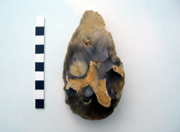
A Swanscombe handaxe
Display 1: Gazetteer of Lower Palaeolithic sites
on Thanet
Display 2: Gazetteer of Middle Palaeolithic sites
on Thanet
Display 3: Gazetteer of Upper Palaeolithic sites
on Thanet
If you are interested in this early period of Prehistory have a look at the website of The Ancient Human Occupation of Britain Project here: AHOB
The website of the National Ice Age Network likewise provides fascinating information on our Ice Age heritage and also gives details of public events where you can get to grips with your history. You can visit from here: NIAN
Version 1 - Posted 23.03.05
Version 2 - Posted 07.04.06
Version 3 - Posted 25.07.06
Version 4 - Posted 21.10.06
All
content © Trust for Thanet Archaeology